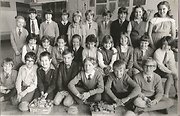 Hartlepool Sports & Leisure
Hartlepool Sports & Leisure
- Cinemas, Theatres & Dance Halls
- Musicians & Bands
- At the Seaside
- Parks & Gardens
- Caravans & Camping
- Sport
 Hartlepool Transport
Hartlepool Transport
- Airfields & Aircraft
- Railways
- Buses & Commercial Vehicles
- Cars & Motorbikes
- The Ferry
- Horse drawn vehicles
 A Potted History Of Hartlepool
A Potted History Of Hartlepool
- Unidentified images
- Sources of information
- Archaeology & Ancient History
- Local Government
- Printed Notices & Papers
- Aerial Photographs
- Events, Visitors & VIPs
 Hartlepool Trade & Industry
Hartlepool Trade & Industry
- Trade Fairs
- Local businesses
- Iron & Steel
- Shops & Shopping
- Fishing industry
- Farming & Rural Landscape
- Pubs, Clubs & Hotels
 Hartlepool Health & Education
Hartlepool Health & Education
- Schools & Colleges
- Hospitals & Workhouses
- Public Health & Utilities
- Ambulance Service
- Police Services
- Fire Services
 Hartlepool People
Hartlepool People
 Hartlepool Places
Hartlepool Places
 Hartlepool at War
Hartlepool at War
 Hartlepool Ships & Shipping
Hartlepool Ships & Shipping

St Joseph's Roman Catholic Primary School
Details about St Joseph's Roman Catholic Primary School
This school opened in 1873, replacing an old school opened in 1857 in a loft in Stockton Street, and closed in 1957 when children were transferred to the nearby new St Joseph's Primary. The school was damaged in World War 2 and the empty Exchange School in nearby Reed Street was also used by St Joseph's until 1957. The old building on the corner of Whitby and Musgrave Streets was demolished in 1967
Location
Related items :
 Damage to St Joseph's Whitby St
Damage to St Joseph's Whitby St
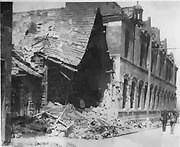 Created by NDM
Donated by Hartlepool Museum Service
Created by NDM
Donated by Hartlepool Museum ServiceDated 1940
On the night of June 19th 1940, the old St Joseph's School was so badly damaged that children could no longer attend. Exchange School was used until 1957.
More detail » First Communicants 1930s
First Communicants 1930s
 Donated by Margaret Hodgson/St Joseph's
Donated by Margaret Hodgson/St Joseph'sMany children unknown and this would be at the Whitby Street School.
The photograph was taken in the schoolyard at the rear of the school, the entrance of which was in Scarborough Street.
The First Communion Mass Saturday 23rd October 1937.
Back row last lady on the right is Miss Sparks, boy directly in front of her is Francis McDonough (donator of this information), the boy to the left of Francis is ? Feeney.
The boy sat in the chair on the right wearing a smart shirt and tie is Attilio Bianco whose family owned the Ice Cream Parlour in Whitby Street.
The boy sitting on the floor in the front row (last on right) is ? Amerigo whose family had the Ice Cream shop on the corner of Elwick Road and Penrhyn Street.
More detail » From Log Book of St Joseph's
From Log Book of St Joseph's
Early Days at St Joseph's by Margaret Hodgson
The world of education was very different in those early days. Before 1870 education was not compulsory. There were only voluntary, private or charitable school or industrial schools. Children were expected to take school pence to school on Monday (4d per week). Most schools relied on ‘pupil teachers’ who received their training ‘on the job’ gradually working their way up from pupil teacher to Article 51 to Certified Teacher.
In 1856 the Department of Education was formed and in 1858 a Royal Commission recommended the principle of ‘payment by results’. From that date the amount paid to a school depended on the attendance of the children and their results in annual examinations in the 3 R’s conducted by the Inspectors. The log books are full of references to the stress caused by these inspections.
In 1870, William Forster’s Education Act provided for the election of School Boards which could build and maintain schools out of the rates and if they chose provide free education. It was not for another 21 years, not until 1891, that elementary education was made free for all children between the ages of 3-14
In 1874 the grant for St. Joseph’s School was £32 18s and 0d. The teachers received miserable salaries about £2 per month and only with the greatest difficulty could the priest find the money.
In 1900 a block grant per head replaced the ‘payment by results’ system. Annual Inspection and examination were abolished. HMI were now more likely to pay visits without preliminary notice.
POVERTY AND GENEROSITY
The school log books and the F.C. J. Annals frequently refer to the dreadful poverty suffered by the children and their families.
1892 - ‘Cold, poverty and misery of very kind was experienced by nearly all our little ones, the distress was greater this year than ever it has been before. People, at other times well to do, were glad to receive a cup of soup and a little loaf of bread at one of the Charity Centres’.
February 1895 - The school log book tells of ‘Great poverty and distress among children owing to severe frost and consequent stoppage of works. Several soup kitchens opened in town and children daily supplied with coupons for food’. The FCJ Annals also record, ‘During the spring of this year, our children suffered very much from the pangs of poverty. Hundreds of men who work in the ship yards and timber yards were thrown out of employment owing to the severe winter, and it was impossible for such a large number to find work elsewhere. Had it not been for the charity dinners supplied by the authorities of the town, many of our little ones would have starved’.
In those days there was no ‘safety net’ for the poor except for charity or the dreaded work house where children were separated from their parents and conditions were harsh. Children from the work house attended St. Joseph’s. In 1898 ‘Boys from workhouse absent from school owing to the presence of typhoid fever at the house. Absent for 5 weeks.’ The school tried to brighten their days. ‘Children from the work house had a tea party in the schoolroom’. (November, 1887)
The poverty and illnesses like measles, diphtheria and scarlatina often took a fatal toll and the log books mention the fairly regular deaths of pupils e.g. 1911 Sept. 17th – ‘one of the school children died and on Wednesday Sept 20th, the children of Standard V were arranged in line outside the school for a few minutes to watch the funeral pass by.’ This funeral was followed a few days later by the death of another child.
But these hard times called forth many examples of generosity.
1905 the log book of the Boys School paints a positive picture of what can be done when describing the free breakfasts given to the poorest children, ‘the caretaker boils the water, makes the tea and assists generally while two members of the teaching staff prepare and distribute the food and maintain order. The local Charity Organisation support the Education Committee. By the sympathetic cooperation of all a good and necessary work is well done’.
1908 ‘The year has been one of great hardship and poverty. A great strike threw nearly all the men out of work and many of the children were almost starving. The town provided free breakfasts for the children of the different schools. These were continued until Easter and began again in October. There were many touching incidents in these sad times. One little girl regularly shared her dinner with those who had none and often the very poor brought in articles of clothing for some child worse off than themselves’.
From the 1917 F.C.J. Annals ‘Usually the School Manager (the Parish Priest) provided breakfast for the FHC children but this year funds were low so an appeal was made to the other children who brought in cakes, loaves, packets of tea et. ‘One weeping child said to the teacher of standard one ‘I’ve no clothes to go in and my mother can’t give me nothing to eat’. The whole class were sympathetic and she was ‘soon arrayed in borrowed plumes’ with her ‘purse well filled with 6d’. She was given more cakes than any of the others so she could take them home to her family. ‘Such is the kindness of the poor to one another’.
Inventory at the opening of St. Joseph’s R.C. Girls’ School
March 23rd 1885
12 desks
1 slate board
1 reading stand
1 attendance board
1 Philip’s multiplication chart
1 Heywood’s weights and measures
1 set script. hist. prints
13 doz. Slates
14 doz. Royal readers
12 table books
12 exercise books
5 copy books
10 arithmetics (Wykes)
1 ream foolscap
6 boxes pens
6 slate pencils
1 gross pen holders
1 gross pencil holders
1 dozen geography readers (Blackie)
1 dozen history readers (Sanderson)
3 chairs
Nowadays our inventory runs to at least 57 pages and we no longer count small items like pencils and pens!
Boys, Girls and Mixed Infants
Children started school at four or five years old and joined the Infant Department. After seven boys and girls were taught separately until they left at the age of fourteen.
WORKING CONDITIONS
Although the new building was a showcase school in 1873 it wasn’t long before overcrowding and lack of facilities were hampering the work of the school. By 1895 in the Girls’ Department they were teaching four classes in one room and it appears that not all children had a desk to sit at.
In January 1900, the head teacher of the boys’ school rearranges the timetable to solve the problem of a dingy building – ‘we take drawing immediately after register to get better light’ and in December 1905 ‘2 teachers complain about poor ventilation. The number in the room should be 62 but average number is 80’.
Electricity was installed in the boys’ school in 1901 but when the school moved to the Exchange Building in 1941 they were once again without electricity and when some visiting sisters come to show a film on the missions the children have to use the Boys’ Club across the road!
1919 Jan 8th ‘temp 27 degrees. Ink frozen. Efforts made to keep warm, extra Physical exercises’.
‘Weather in January extremely cold, 26 degrees indoors on many days’. ‘With fingers stiff with cold and with frozen ink, it was almost impossible to do much work. Before the registers could be marked, the ink had to be thawed.
Occasionally, all the children are sent home because they ‘are too wet to continue’.
In 1934, the F.C.J. Annals were determined to look on the bright side, ‘January came in, cold, crisp, frosty and sparkling in the noonday sun. The climate may be severe but the atmosphere is invigorating and conducive to longevity’.
After the bombing the school eventually moved into the Exchange building which had been declared unfit for use as a school in 1934 (or perhaps even earlier, Sr. Agnes Morgan thought it was 1911).
By 1952, conditions in the Exchange Building in George Street were fast approaching a scandal. There was one toilet for 110 boys, no central heating and no electric lighting.
‘For the past few months our school has been the talk of the town, for our inadequate lighting, heating, sanitary and fire prevention arrangements have been broadcast to the public by several newspapers ‘ (F.C.J. Annals). Sr. Bernadette remembers that one of the headlines in the local newspaper screamed ‘Children at St. Joseph’s cannot read’. This referred to the fact that in the afternoon, during the winter months, as housewives began to prepare the evening meal the gas pressure dropped and the light in the school dimmed to such an extent that it was too dark to read or write. Sr. Bernadette remembers that teachers could not see children sitting in the back benches. Teachers had to use their ingenuity to come up with activities which did not require much light! Communal singing quickly became a favourite.
GOOD TIMES
The Feasts and Holy Days of the Church’s year were bright spots in the life of the school. First Holy Communion days were celebrated with all the style the staff and families could provide. 1893- ‘Reverend Manager (the parish priest) provided veils for nearly 40 who could not afford veils as well as ‘a handsome card as a souvenir of that happy day’, substantial breakfast served ‘
Life was hard but throughout the year the School arranged trips and treats for the children. There were Christmas parties and trips to Seaton Snooks, Blackhall Rocks, Crimdon and down onto the beach. I wonder what risk assessments were carried out before this trip to Blackhall…’a special prize given for the best bunch of wild flowers gathered on the cliffs’.
There are frequent references to kindly visitors who bring crates of oranges and Christmas cards or who dressed as Santa Claus and gave out gifts (1908).
The teachers often bought little presents or cards for the children or paid for school trips. ‘The teachers showed themselves very generous in the case of some poor little ones who could not afford the tram fare. (1906)
1925 ‘Over 1,500 Catholic children of the town were entertained at the New Picture Hall and given a bag of sweets and cakes as they left. – all courtesy of a Catholic gentlemen recently returned to the town’.
The girls from the convent school regularly brought warm clothing that they had made and donated it to the children of St. Joseph’s.
INSPECTIONS
Inspection Reports were certainly a great deal shorter in the early days. The 1886 report was only 7 lines long. Although the ‘school is doing good and useful work English is not sufficiently good to earn the recommendation of a grant’. Inspectors certainly pulled no punches; the 1887 report begins ‘The school is doing a very useful work amongst a somewhat low class of children’ and in 1897 states ‘I am most disappointed with the want of intelligence in this school’.
More often than not the inspectors were very complimentary e.g. (1901) ‘The tone and discipline of this school are excellent and the teaching is very thorough’ but the prospect of an inspection was feared, ‘This year we dreaded the examination to come round as a great number of our children had been forced to remain away from school for a long time for one cause or another. The government Inspector usually so harsh and exacting was more than paternal, we scarcely knew him to be the same man; as a mark of his confidence and trust in our work, he exempted all our schools from examination and gave us the highest merit grant’.
When there was a startling announcement of an inspection at the convent school in April 1904: ‘each one braced herself to undergo the dreadful ordeal!’
The report of June 1904 is one that any school would be delighted to receive. ‘The discipline is of the best kind – the order in the classes is perfect. It appears to spring from the happy state of feeling existent between the teacher and the child and not from any fear of punishment’. (F.C.J. Annals)
One of the nuns tempted fate in 1912 when she wrote, ‘we rarely have an inspection of any kind’. The next year they were inspected twice! ‘One day in July when almost every other department was enjoying the half holiday, in walked 2 of HM Inspectors, followed a few minutes later by their chief. They had not troubled us for three years, so they entered very thoroughly into everything and returned the following week to finish their work. After the summer holidays and when we had received an excellent report on the work of the school we were again ‘surprised’.
As a Catholic School, St. Joseph’s regularly underwent ‘Religious Examinations’ which usually resulted in a highly complimentary report.
CRIMES AND PUNISHEMNTS
Not all Victorian Schools took a casual approach to corporal punishment and parents weren’t always seen and not heard!
On February 26th 1890 the Boys’ Log Book records the ‘Case of punishment by Mr. Arnold. John Booth St. IX did not do his grammar well and was punished by his teacher. On coming down to school in the afternoon Mrs. Booth brought her boy and showed the mark on boy’s face and brow. Complained of Mr. Arnold’s conduct. The latter explained and expressed regret.
I afterwards spoke to Mr. Arnold about it and pointed out once more that the managers strictly enjoin that all corporal punishment shall be given by the principal teacher. Assistant teachers are strictly prohibited from using corporal punishment.’
In 1908 there were complaints by neighbours about the boys’ behaviour to Japanese visitors. I wish the Head had filled in the details...who were these visitors and why were they in Hartlepool?
More detail » History of St Joseph's (1) 1857-1957
History of St Joseph's (1) 1857-1957
St Joseph’s School 1857- 1957 by Margaret Hodgson
Introduction:
2007 is a year of Jubilee for St. Joseph’s R.C. School in Hartlepool. The school was founded in 1857 (in a loft over a warehouse) and then in 1873 a purpose built school was opened. It was this building, on the corner of Musgrave Street and Whitby Street, which was bombed in 1940. St. Joseph’s was rebuilt in 1957 on the present site of Musgrave Street and Tower Street. So we are celebrating 150 years as well as our Golden Jubilee.
Nowadays, St. Joseph’s is something of a ‘hidden gem’. The school’s postal address is Musgrave Street but as Musgrave Street no longer exists many a visitor or delivery van has had to search to find us! They assure us it is well worth the effort! During our Jubilee year we hope to offer a warm welcome to friends old and new as we share our celebrations.
St. Joseph’s has a rich and interesting history of service to the children of Hartlepool, the local community and the Church. I hope that this history of the school gives some flavour of the joys and sorrows of the school through the years. It is impossible not to reflect that whilst so much has changed so much has stayed the same. This history is drawn mainly from the school log books and Annals of the Order of the Faithful Companions of Jesus (F.C.J.) as well as books on the history of the Church in Hartlepool. Our Jubilee celebrations will be an opportunity for past pupils and staff to share their memories with the current generation. Our next project will be to compile a history of the school since 1957 as well as to record the precious eye-witness accounts of our ‘old boys and girls’. I hope anyone who recognises a friend in a photograph or who has a story to tell will contact the school.
This booklet is dedicated to Sr. Bernadette Cassidy F.C.J. whose long years of service to the school, love of its children and passionate interest in its history are an inspiration.
Margaret M. Hodgson (Head Teacher)
St. Joseph’s R.C. Primary School
Musgrave Street,
Hartlepool
Growing and Building
It is not easy to track down the beginnings of our school; there are conflicting reports. According to the Northern Daily Mail of 14th May 1927 ‘St. Joseph’s Elementary School commenced in 1857 in a loft in Stockton Street where the Crown Inn now stands’[1]. It appears that it later moved to a loft over a warehouse in Princess Street. This was a Day school run by Miss Margaret Hedley and assisted by Miss Fanny Taylor and Miss Susanna Loam. This was in the days before the Parish of St. Joseph’s was founded so the loft was also used by Fr Knight and Fr. Harivel to ‘instruct the people in the Faith and offer a service on Sunday evening’[2]. St. Joseph’s has often been a school on the move. The room above the warehouse in Princess St. was not considered very satisfactory as a school. Fr. Dwyer sold land at Belle Vue which had been bought as a site for St Joseph’s church. With the money he bought a site for a new school in South Whitby Street in 1870. In 1871 the foundation stone was laid by Canon Knight of Hartlepool. The school was opened after Easter in 1873 at a cost of £1,500 and Miss Susanna Loam was the first headmistress. At first the school was a mixed school for 330 children and in 1873 was considered to be one of the finest in the town. People involved in school building travelled for miles to see this up to date school. There is some confusion as to when the school moved from the loft as the F.C.J. Annals of 1934 state that ‘When Mother Clare Carroll opened the school, she began with 50 girls and infants in a room rented over a shop’. The F.C.J. order did not arrive in Hartlepool until 1885.
The Church of the time always made the education of the young its priority. Although the Catholics of West Hartlepool longed for a new Church (mass was said in the skating rink or in halls around the area) every time the parish saved enough to begin building the money was diverted to the school in order to accommodate the increase in pupil numbers. The Church of St. Joseph’s was not built until 1895 although the parish had been established in 1867.
The explosion in the Catholic population at this time mirrored the increase in the general population as workers from all over the British Isles streamed to Hartlepool to work in the docks, the railways and other trades. In 1832, a railway was built from the nearby Durham coalfields to Hartlepool where the port was extended. However the small port could not handle all this trade and Ralph Ward Jackson, in 1847, opened new docks very near Stranton to the south west of Hartlepool[3].
The area around the docks became inundated with newcomers to the area and the new town was called "West Hartlepool". It quickly engulfed the ancient village of Stranton and by 1861 had a population of 14,515. The new town became a centre not only for coal export, but for iron works, shipbuilding and all the associated trades. The population continued to rise dramatically:
1851 – 4,769, 1861 – 14,515, 1871 – 23,246, 1881 – 30,914, 1891 – 44,252, 1901 – 63,756
In the 1880s the School once again became very overcrowded and as a temporary measure Fr. Crolly rented Halladown Hall in Park Road to ease the situation. A new school built in 1890 for girls and infants (£2,000), adjoining the old school and was placed under the care of the nuns while the old original building became the Boys’ school only under the care of Mr. Christopher Lynch (head for 46 years 1874-1920). At that time it cost between £8-9 per place to build a new school. In 1965 it was £175. Paul Briggs (Assistant Director of Children’s Services) estimates that, in 2007, it would cost around £3milllion to rebuild a school the size of St. Joseph’s; this works out to around £18,000 per place!
During the next eleven years the Catholic population of Hartlepool continued to rise so in 1901 Fr. Wickwar was forced to look around for even more accommodation. St. Joseph’s took over a building near corner of Mildred Street and Hart Lane which became known as Hart Lane School for infants. (This was closed in 1934 with the opening of Sacred Heart School.)
In 1910 space was once again in short supply so a disused Church of England school at Stranton was used and several Standards or classes remained there until 1914 when St. Cuthbert’s was built. Miss G. Jones was the teacher in charge and Miss Granville went with her under the supervision of Mr. Lynch.
The Children of the school were once more on the move in 1939. The vulnerable position of the Hartlepools led to the call for the mass evacuation of local children. On the 4th September 1939 St. Joseph’s School was closed indefinitely after the declaration of war. Plans for evacuation were well advanced and on 8th September 1939 117 girls and 2 teachers (Miss Corcoran and Miss Anderson) left by train for Whitby. At first attendance at school was voluntary. For those who remained at home these places were used for group teaching: Eden Villa, Tower St (Mrs. Timlin’s), 8 Archer Street (Miss Allen’s), 71a Whitby Street (Miss Massey’s,) 19 Surtees Street (Miss Eggleston’s), The Corporation Hall, South Street, Old Town. For a time, St. Joseph’s senior boys were accommodated at St. Joseph’s Men’s Club in Reed Street, where the only available playground was the back street. Sr. Veronica Garner F.C.J. (June Garner) remembers having lessons in the Billiard Hall over a cafe using the billiard table to work on.
The F.C.J. annals record ‘St. Joseph’s had to share the common fate in September. The evacuation order did not meet with a willing response. People could not see more safety for their children at the coast towns of Whitby and Scarborough than at home in West Hartlepool, especially as children from Newcastle and Hull were billeted at Seaton. Of course they forgot that Hartlepool is a “fortified port” and submarine harbour. It is also a mine-sweeping base. At an educational meeting it was decided that the secular teachers would evacuate in turn and the nuns work at the house system of teaching at home’.
Some children returned home after a few weeks or months, others stayed away until the end of the war. In 1940 the school was bombed. Some more children were evacuated; others ‘spread round’ the local area being taught in houses and rooms above businesses; some classes were taught in Ward Jackson School. In 1941 the school moved into the Exchange building in George Street (now the Reproduction Centre). This building had been declared unfit for use as a school in the early 1930s, had been used and abandoned by the military and was now once more in use as a school.
Mother Agnes Morgan recalls in her memoirs, ‘the old St. Joseph’s School was bombed during the war but it was completely destroyed and the children were housed in an old Board School that had been empty since 1911. In spite of many inconveniences this was a very happy school thanks mainly to Mother Margaret O’Brien whom I replaced. There was no central heating, no electricity or running water and when there was a gas leak the children were moved from one room to another. There was no playground so we were allowed to take the children for games etc. on the beach.’
The school moved one last time in 1957 when the new school was opened on Musgrave Street but not without a few false starts. The F.C.J. Annals of 1956 record:
‘At the beginning of July the teachers of St. Joseph’s were told to pack, as the new school was near completion. The next three weeks were busy ones, the children brought in dozens of empty cartons and boxes while the bin men removed the accumulation of fifteen years. The last Monday of the term saw bare walls, unsightly and crumbling, empty shelves and cupboards and piles of boxes and bundles in every corner. At 10 am an inspector arrived for a General Inspection of the school. Although there had not been an inspection in the school for about eighteen years, yet no one expected it in the last week of term. However, if there were no tidy books to see, neither were there any untidy ones. The ordeal lasted two and a half days and, although the inspector was very helpful and considerate, all breathed a sigh of relief when it was over.
Towards the end of the holidays news came that St. Joseph’s new school was not quite finished so we returned to the old spot. As the term wore on, cupboards gradually filled again, so by Christmas we were back to normal. There is no hope of going to the new school until the work is finished.’
The long awaited final move was a great day for the children and staff. Mother Agnes Morgan writes, ‘so again I had the joy of moving but this time it was only over two streets. We got two days in Holy Week to move in so when the pupils came back after Easter there was great rejoicing. We had a lovely building, a big playing field, a hard court and a rose garden. During the first play periods the children just ran round and round the field. Even the teachers and the caretaker joined in this mini marathon’.
As far as we know, there are no plans for the school to move again!!
[1] Catholic Church in Hartlepool and West Hartlepool p.27
[2] From Down Your Aisles by Michael Morris and Leo Gooch pp. 146 - 150
[3] West Hartlepool by Robert Wood
 Model Making and Sewing
Model Making and Sewing
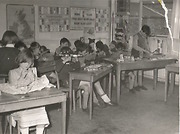 Donated by Margaret Hodgson/St Joseph's
Donated by Margaret Hodgson/St Joseph'sInterstingly this photograph from what looks to be the early 1960s, shows the boys making models and the girls sewing. How times change as this stereotyping would be perfectly normal in those days !
More detail » Musgrave Street from Scarborough Street
Musgrave Street from Scarborough Street
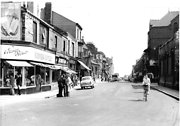 Created by West Hartlepool Council
Part of the Library collection collection
Created by West Hartlepool Council
Part of the Library collection collectionDated 1955
Taken in 1955 looking east along Musgrave Street from Scarborough Street. The World War 2 bomb damaged old St Joseph's School is on the right and St James' Church on the corner of Whitby Street can be seen on the left.
The photo was from a photographic record of the Central Area of West Hartlepool prepared in 1955/6 at the request of the Town Planning and Redevelopment Committee 'in the hope that it will be of interest to future generations of West Hartlepool'
The record focuses on areas which were within the next ten years to be completely redeveloped following The Max Lock Plan. It was compiled by WL Taylor and photographs developed by Thomas Clarkson Chemist of Tower Street.
More detail » Nativity
Nativity
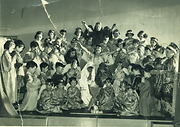 Created by unknown
Donated by Phil and Penny Dixon
Created by unknown
Donated by Phil and Penny DixonDated 1959
A packed stage for the Nativity at St. Joseph's School in December 1959. Somewhere in the crowd is Phil Dixon. There is a photo showing the same cast in Hartlepool Mail 23rd December 1959.
More detail » Saying Prayers
Saying Prayers
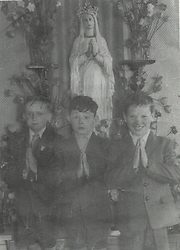 Created by unknown
Donated by Phil and Penny Dixon
Created by unknown
Donated by Phil and Penny Dixon St Joseph's Early Memories of Carlton Camp
St Joseph's Early Memories of Carlton Camp
Compiled by Margaret Hodgson
Carlton Camp was a great experience for the children. Mrs. Ursula Mary Craig (nee Knight), Richard Court, Hartlepool wrote this account for the Hartlepool Mail.
Memories of Carlton Camp: Straw from the farm for sleeping mats.
With reference to the letter in Memory Lane about Carlton Camp Outdoor Centre school visits (November 20), I was there in 1935, the second week after it opened. I was 13 years old, I am now 82 and I can remember nearly everything about it.
I was with St. Joseph’s School; St. Cuthbert’s School was there at the same time.
Usually the visit was Saturday to Saturday but as the two schools were Catholic we had to go to Mass on Sunday so we went Sunday to Saturday.
We were told to take two blankets, a pillowcase and pocket money of not more than three pence. I had one penny as I was from a big family and my dad was unemployed.
We set off at 11 o’clock and arrived for Sunday lunch. We ate lunch, moved the tables, washed up the dishes and then were given bags made of Hessian; they were long and about 36 inches wide.
We were told to take them down to the barn belonging to the farm and fill them with straw. These were what we were to sleep on, on the floor with our pillow cases on the pillows; they were all placed close to the walls stacked on top of each other.
We were then told we could go out to play, but ‘not outside the field.’
There were seesaws – and a rush to get to them. We spent the rest of the afternoon playing games, and then it was teatime. After tea we had to put our ‘mattresses’ on the floor in a line and put one blanket over it, then the other blanket was to cover over us, we all slept well.
When we awoke we went to the annex where there were six wash sinks and six toilets. The towels were provided – two roller towels for all of us – did the job. After breakfast we were given a small task each – housework – washing up and sweeping the floors.
After lunch Miss Anderson and Miss Corcoran, the teachers, took us all for a ramble up into the hills, they were beautiful.
On Tuesday after lunch we were given a sheet of writing paper and an envelope, we had to write a letter to our parents.
On Wednesday we walked to the village to post the letters. At that time a stamp was one penny, and that is all I had. All the other girls were buying sweets, I did not want to be left out so instead of sealing the letter I put the flap inside and bought a halfpenny stamp and then I got a halfpenny-worth of marzipan teacakes so I wasn’t left out. As we walked further into the village there was a stream in the middle of the road and we heard a clip-clop, out of a lane came a party of hunting men and women, they looked fantastic in their red and black outfits. We did a lot of walking at Carlton Camp. It did not cost our parents anything, perhaps some organisation paid, I don’t know. But we had a great time!
In 1937 Carlton camp was certainly eventful!! On the 26th of September 113 boys set off to camp with 4 teachers. Two days later Jas. Charlton is brought back and admitted to isolation hospital. Seven boys were taken out to the camp and a further two sent home, one with tonsillitis. Paul Knox stabbed William Myers in the eye with a pencil!’ Can you imagine a trip where 113 children are accompanied by only 4 teachers? I wonder if any of the boys on the eventful 1937 trip are in the Carlton Camp photos which were taken sometime in the 1930s.
More detail » St Joseph's Roman Catholic Primary School
St Joseph's Roman Catholic Primary School
This school opened in 1873, replacing an old school opened in 1857 in a loft in Stockton Street, and closed in 1957 when children were transferred to the nearby new St Joseph's Primary. The school was damaged in World War 2 and the empty Exchange School in nearby Reed Street was also used by St Joseph's until 1957. The old building on the corner of Whitby and Musgrave Streets was demolished in 1967
More detail » St Joseph's School 1955
St Joseph's School 1955
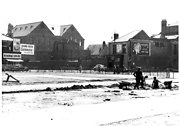 Created by West Hartlepool Council
Donated by Hartlepool Library Service
Created by West Hartlepool Council
Donated by Hartlepool Library ServicePart of the Library collection
Dated 1955
The view is the site of St Joseph's School just as it is to be built. Workwear Supplies is on the corner of Musgrave Street and Scarborough Street. On the other side of Musgrave Street, the bomb damaged first St Joseph's School can be seen and the large building behind is the Co-op Whitby Street premises.
The photo was from a photographic record of the Central Area of West Hartlepool prepared in 1955/6 at the request of the Town Planning and Redevelopment Committee 'in the hope that it will be of interest to future generations of West Hartlepool'
The record focuses on areas which were within the next ten years to be completely redeveloped following The Max Lock Plan. It was compiled by WL Taylor and photographs developed by Thomas Clarkson Chemist of Tower Street.
More detail » St Joseph's School Football Team 1969-70
St Joseph's School Football Team 1969-70
 Donated by Margaret Hodgson/ St Joseph's
Donated by Margaret Hodgson/ St Joseph'sDated 1970
St Joseph's School football team taken in 1970
More detail » St Joseph's School after demolition
St Joseph's School after demolition
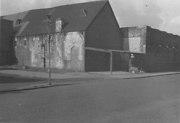 Created by Bill Boagey
Donated by Hartlepool Museum Service
Created by Bill Boagey
Donated by Hartlepool Museum ServicePart of the Bill Boagey collection
St Joseph's School, Whitby Street South. Opened in 1873 at a cost of £1,500. It had 330 pupils. New school built in 1890.
It was hit by a Zeppelin in WW1 and bombed in June 1940. It was never used again.
More detail » St Joseph's School in two world wars
St Joseph's School in two world wars
ST. JOSEPHS IN A WORLD AT WAR
F.C.J. Annals 1914
‘There was no sound of carol singing or other music in the streets, for the shades of death and suffering lay over Hartlepools. Heart rending details still reach us’.
‘To our great grief we heard that one of our little ones had been killed. When her house was struck by a shell, she and her sister aged four, escaped from the Mother and ran into the street, only to meet her death…. The younger one said: ‘Maggie’s leg fell off – she then sat down and went to sleep, and opened her eyes and died….A child from the infant’s school was so badly injured that her arm had to be amputated in the workhouse hospital.
On the morning of the 18th there was a panic caused through a false report that the Germans were again upon us. The people, terrified by the experiences of the 16th, fled from their homes wild with fear, On our way to school we met women half clothed, unwashed, trailing their children after them and carrying such of their belongings as they could pick up. It took some hours to reassure and calm them and to prevail upon them to return to their homes; but there was no more school after that. We closed for the holidays and returned on the following Monday to put all in order. Great was our astonishment on finding the playground full of children. On being asked what brought them back: The Goose, Mother, the Party! They called out. Not to disappoint them we raffled the goose which fell to the lot of a poor fatherless child. We postponed the party till after the return’.
1915 ‘Attendance is poor after the bombardment. School starts at 9.30 in case there is another attack. Attendance officers’ weekly report sometimes says ‘left town’, ‘scared to death’ ‘suffering from bombarditis’. Tea party encouraged nearly all to return! ‘There is scarcely a child without someone in the firing line.’‘No meetings of the Guild of St. Agnes in the evenings as the unlit streets are unsafe’.
There was still time for celebration even in the darkest days of war. ‘Empire day celebrated with flags and patriotic songs. One passer by said’ I have been round several schools but yours beats them all’.’ ( F.C.J. Annals 1915)
Mr. W. Thomas left the school in 1915 to join the Navy.
The war provided the opportunity for some recycling 1916 style!! The school staff and children were asked to do some government work for the soldiers.‘O gruesome thought’ the staff and children of the school had been asked to make sacks from old dirty sacks of different sizes that would be filled with chaff and used for bayonet practice. ‘Of course all other work had to be set aside and for some days the school not only looked but smelt like a rag warehouse. There were sacks to the right of us and sacks to the left all day long…Of course the children were delighted and never attended so well or so early….One child pricked her finger and blood poisoning ensued but with no serious results.’ ’ ( F.C.J. Annals 1916)
In a raid ‘one of the teachers injured and everything in her house destroyed except a picture of St. Anthony on the wall’.
‘Through out the year the older girls worked hard knitting scarves socks and mittens, one of the parents said ‘what with this knitting we can’t get the children to do nothing else’. Each month the children received honourable mention in the Mail and 2 of the teachers were presented with brooches with the letters WW (War work) – making head bandages for the VAD and lunch bags for the soldiers rations’.
14th, 15th and 18th of March 1918
‘…Air raid last night. Bomb fell near the school and shattered all windows at East end of the school. Not possible to carry on this morning.’
‘…Guard of soldiers in one of the rooms to protect the property’.
‘Found school in use as military billet for soldiers guarding the houses near…classes compressed into four rooms and work proceeds’.
The end of the War was a cause for great rejoicing. In November 1918, all the ‘Picture Halls (were) open free to children every afternoon during the week in honour of the conclusion of the war. Only 82 children attended school that week’. There were Peace Teas, parades and celebrations throughout the town.
In 1919, ‘Mr. Thomas Connolly returned after three years army service. He obtained a commission and was badly wounded in the ankle but is now happily recovered.’ There is no mention of Mr. Thomas who joined the Navy in 1915.
In 1921 there must have been great sadness mingled with pride as a memorial tablet was unveiled in honour of ‘102 boys of St. Joseph’s who fell in the Great War’.
Second World War
June 20th 1940 St. Joseph’s Boys’ school log book
‘During the night an air raid took place. A bomb dropped in Whitby St., close to the east end of the Boys Dept., caused very considerable damage to the whole building , so that it is most improbable that the present buildings will ever be used again.
After reporting the extent of the damage to the Education Offices, the teachers proceeded to salvage as much as possible. We were able to remove from the Headmaster’s room, which was completely wrecked, all the permanent records, Log Book, Admission Registers etc. etc.
June 21st and 22nd
Work of salvage continued – saving as much as possible of the perishable stock. Rain on June 21st damaged much of stock.
‘On the night of 19th June 1940, 12. 10 Am., six high-explosive bombs were dropped in the streets and on the houses in the neighbourhood of St. Joseph’s school. The school was shattered, window panes blown in etc. It was impossible to use the school. For one week the teachers attended daily, doing salvage work under very difficult conditions….after about a fortnight, classes were held in the Corporation Hall, Pilot St.; The Guides Hall, Osborne St.; Miss Egglestone’s, Surtees St., and two classrooms in the Convent Grounds. (St. Joseph’s girl’s school log book)
In 1940 Mr. Coleman, Mr. Beldon and Mr. Timlin were called up for military service.
Many of the children had Fathers fighting around the globe and had not seen them for years. The F.C.J. Annals of 1944 tell a sad tale. ‘One of the priests present at the Christmas party, a Chaplain to the Forces and a former curate of St. Joseph’s Parish, was claimed by several of the “fives” and “sixes” --- “He’s my daddy”. “No, he’s not, he’s mine”, and they crowded round him, attracted by the uniform which they had perhaps seen their daddy wear. It was very pathetic: many of the children have no remembrance of their father.’
More detail » St Joseph’s 1956
St Joseph’s 1956
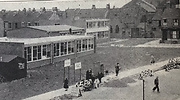 Created by NDM
Donated by Hartlepool museum service
Created by NDM
Donated by Hartlepool museum serviceDated 1956
Taken in October 1956, St Joseph's School in Musgrave Street is almost complete and demolition round about will become playgrounds.
More detail » Whitby Street looking north 1955
Whitby Street looking north 1955
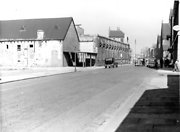 Created by West Hartlepool Council
Part of the Library collection
Created by West Hartlepool Council
Part of the Library collectionDated 1955
The old St Joseph's R.C. School which was destroyed by enemy bombing 19/20 June 1940 is on the left. Across Musgrave Street, St James' Church is visible near the cars.
The photo was from a photographic record of the Central Area of West Hartlepool prepared in 1955/6 at the request of the Town Planning and Redevelopment Committee 'in the hope that it will be of interest to future generations of West Hartlepool'
The record focuses on areas which were within the next ten years to be completely redeveloped following The Max Lock Plan. It was compiled by WL Taylor and photographs developed by Thomas Clarkson Chemist of Tower Street.
More detail »




